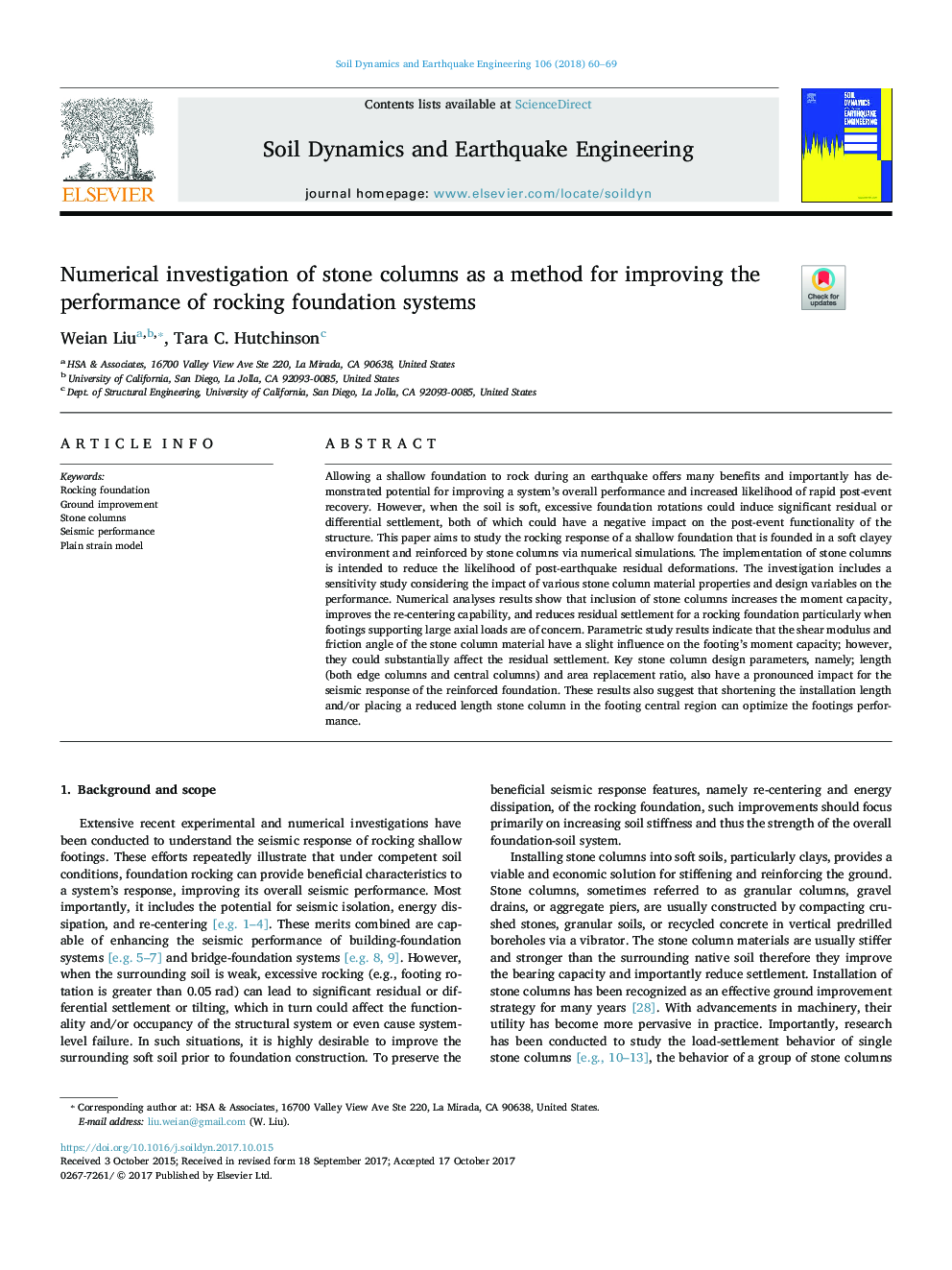| کد مقاله | کد نشریه | سال انتشار | مقاله انگلیسی | نسخه تمام متن |
|---|---|---|---|---|
| 6770770 | 1431687 | 2018 | 10 صفحه PDF | دانلود رایگان |
عنوان انگلیسی مقاله ISI
Numerical investigation of stone columns as a method for improving the performance of rocking foundation systems
ترجمه فارسی عنوان
بررسی عددی ستون های سنگی به عنوان یک روش برای بهبود عملکرد سیستم های شیب دار
دانلود مقاله + سفارش ترجمه
دانلود مقاله ISI انگلیسی
رایگان برای ایرانیان
کلمات کلیدی
پایه سنگک بهبود زمین، ستون های سنگ عملکرد لرزه ای، مدل کشش ساده
ترجمه چکیده
اجازه دادن به بنیاد کم عمق برای سنگ در طول زلزله مزایای بسیاری را ارائه می دهد و مهمتر از همه این است که بالقوه برای بهبود عملکرد کلی سیستم و افزایش احتمال بازگشت سریع پس از رویداد نشان داده است. با این حال، هنگامی که خاک نرم است، چرخش بنیادی بیش از حد می تواند باعث ایجاد اختلاف زیادی در محل و یا محل اختلاف شود، که هر دو می تواند تاثیر منفی بر عملکرد بعد از رویداد ساختار داشته باشد. هدف از این مقاله بررسی واکنش بتنی کم عمق است که در یک محیط آرام نرم شده و توسط ستون های سنگی با استفاده از شبیه سازی های عددی تقویت می شود. اجرای ستون های سنگی در نظر گرفته شده است تا احتمال ایجاد تغییرات پس از زلزله را کاهش دهد. تحقیقات شامل یک مطالعه حساسیت با توجه به تاثیر مواد مختلف سنگ ستون ستون و متغیرهای طراحی بر عملکرد است. نتایج تجزیه و تحلیل عددی نشان می دهد که استفاده از ستون های سنگی ظرفیت لحظه ای را افزایش می دهد، قابلیت مرمت مجدد را بهبود می بخشد و باعث می شود حل و فصل باقیمانده برای بنیاد تیراندازی به خصوص هنگامی که پایه های بارهای محوری بزرگ نگرانی است، کاهش یابد. نتایج بررسی پارامتری نشان می دهد که مدول برشی و زاویه اصطکاک مواد ستون سنگ تاثیر کمی بر ظرفیت لحظه پایه دارند. با این حال، آنها می توانند به طور قابل توجهی حل و فصل باقی مانده تاثیر می گذارد. پارامترهای طراحی ستون کلید سنگ، یعنی؛ طول (دو ستون لبه و ستون مرکزی) و نسبت جایگزینی منطقه نیز دارای تأثیر مشخصی برای پاسخ لرزه ای پایه تقویت شده است. این نتایج همچنین نشان می دهد که کاهش طول نصب و / یا قرار دادن یک ستون طول سنگ کوچک در منطقه مرکزی پایه می تواند عملکرد پایه را بهینه سازی کند.
موضوعات مرتبط
مهندسی و علوم پایه
علوم زمین و سیارات
مهندسی ژئوتکنیک و زمین شناسی مهندسی
چکیده انگلیسی
Allowing a shallow foundation to rock during an earthquake offers many benefits and importantly has demonstrated potential for improving a system's overall performance and increased likelihood of rapid post-event recovery. However, when the soil is soft, excessive foundation rotations could induce significant residual or differential settlement, both of which could have a negative impact on the post-event functionality of the structure. This paper aims to study the rocking response of a shallow foundation that is founded in a soft clayey environment and reinforced by stone columns via numerical simulations. The implementation of stone columns is intended to reduce the likelihood of post-earthquake residual deformations. The investigation includes a sensitivity study considering the impact of various stone column material properties and design variables on the performance. Numerical analyses results show that inclusion of stone columns increases the moment capacity, improves the re-centering capability, and reduces residual settlement for a rocking foundation particularly when footings supporting large axial loads are of concern. Parametric study results indicate that the shear modulus and friction angle of the stone column material have a slight influence on the footing's moment capacity; however, they could substantially affect the residual settlement. Key stone column design parameters, namely; length (both edge columns and central columns) and area replacement ratio, also have a pronounced impact for the seismic response of the reinforced foundation. These results also suggest that shortening the installation length and/or placing a reduced length stone column in the footing central region can optimize the footings performance.
ناشر
Database: Elsevier - ScienceDirect (ساینس دایرکت)
Journal: Soil Dynamics and Earthquake Engineering - Volume 106, March 2018, Pages 60-69
Journal: Soil Dynamics and Earthquake Engineering - Volume 106, March 2018, Pages 60-69
نویسندگان
Weian Liu, Tara C. Hutchinson,
